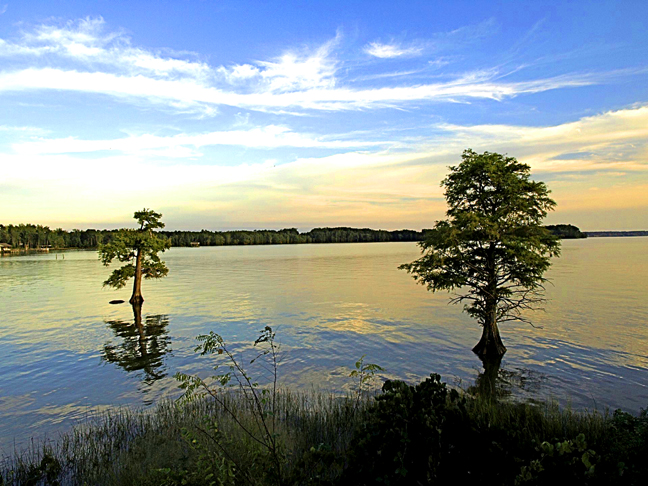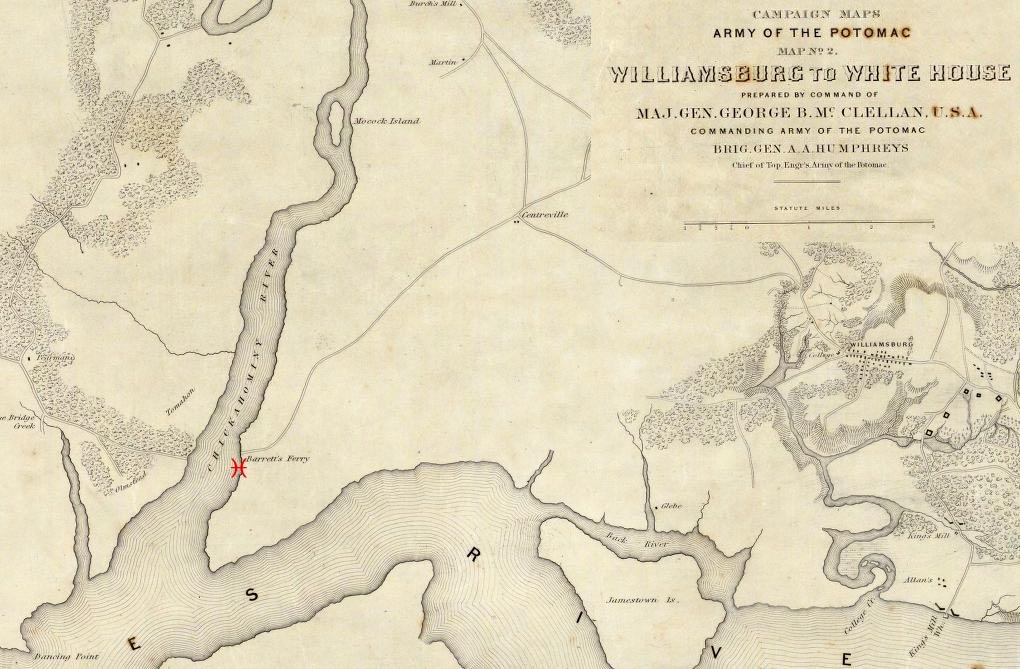

HOMES AND LAND IN HISTORIC WILLIAMSBURG, VIRGINIA

 |
There is a place just west of
historic Williamsburg, Virginia where the land slopes
gently to the shores of the great Rivers of History where
America began. That land is now ready for you to
make your own history while living in harmony with the
River. That land is waiting for you at Barretts
Ferry Landing. Four exclusive waterfront estate properties are now available, created from the forest and fields granted to William Barrett in 1648, each with frontage on the River and a distinct character forged from the past 360 years of living on and caring for this land. |

Hornsby Real Estate is
excited to offer four Distinctive Estate Properties at Barrett's
Ferry Landing
Lot 6, The Orchard,m 1497 John Tyler Highway,
features 5.37 acres in a combination of wooded and open land that
was the location for fruit bearing trees over the years.
With two hundred and eighty feet fronting on the river, this land
provides a wonderfully balanced building site with opportunities
for creating forest paths leading to the waterfront. $500,000.00 SOLD!!
Lot 4, The Overlook, 1489 John Tyler Highway,
features 4.92 acres of broad open land with substantial views
overlooking both the James and Chickahominy Rivers. The two
hundred and fifteen feet of frontage on the river with a small
sandy beach is the ideal location for your boat dock. The
view overlooking the sunset over the James River is truly
exceptional. $575,000.00 SOLD!!
Lot 3, The Homeplace 1485 John Tyler Highway,
features 5.05 acres of open land and is the former site of the
family home. This land boasts broad panoramic views of the
Chickahominy and James Rivers. A dock and other waterfront
recreational activities will be well placed on the two hundred
and forty feet of frontage on the river. The sunset views
over the James River are astounding. $625,000.00 SOLD!!
Lot 2, The Paddock, 1481 John Tyler Highway,
features 4.83 acres of open land and has historically been the
location for barns and other equine related outbuildings.
This property has extensive views of both the James and
Chickahominy Rivers. With two hundred and twenty-five feet
fronting on the river, a private boat dock will be the perfect
addition to highlight the waterfront experience. The sunset
views over the James River are breathtaking. SOLD!!
Click here to Downolad a Barrett's Ferry Landing
Plat
Suitable for Printing (Adobe PDF file)
 |
Barrett's Ferry Landing offers the best of Virginia: 1. Private access to your own riverfront. 2. The acreage and freedom to have both personal homes, outbuildings, and recreational facilities on your own land. 3. Close to shopping, dining, & the cultural offerings of Williamsburg. |

This waterfront property is located on the historic John Tyler highway, just west of Jamestown and 7 miles from downtown Williamsburg and the College of William and Mary.
This Land is Rare and Outstanding!
Call Bobby Hornsby today for more details!
(757) 565-0100
Send E-mail to Hornsby Real Estate Co.
Hornsby Real
Estate Co.
4732 Longhill Road, Suite 1101
Williamsburg, Va. 23187
Phone: (757) 565-0100
Call Hornsby First!!!
A History of Barrett's Ferry Landing:
The Virginia Company of London was an English
joint stock company established with a royal charter by King
James I of England on April 10, 1606 for the purpose of
establishing colonial settlements in the New World. The Virginia
Company was responsible for founding the Jamestown Settlement and
expanding the English Colonies in North America. One of the major
tools used to recruit future Colonists was the “headright
system”, whereby a settler was granted fifty acres of land
for every person he brought to the colony.
In 1648, Mr. William Barrett was granted, in return
”…for the transportation of fourteen persons into the
colony…”1 a
Land Patent of 700 acres on the eastern bank of the Chickahominy
River at the confluence with the James River. Sometime between
the Virginia Company grant and 1690 William Barrett and his
family established a ferry on their land to provide a river
crossing on the road between Williamsburg, the James River
Plantations, and Richmond to the West. This is the location of Barrett’s
Ferry Landing.
The remains of the ferry landing are still visible at a deep low
tide, with large timbers embedded in a base of a coral-like rock
typically brought from the Bermudas or Caribbean as the ballast
used by the great sailing ships involved in the tobacco trade
with the English colonies. If you want to find the ferry landing,
walk “down along the river and just look for the biggest
cypress tree down there, and that one is probably 400 years old
and is even referred to in some articles from 1933” about
“the big cypress tree that marks the entrance to the old
ferry.”2
For about one hundred years, the Barrett family
ran the ferry in relative peace and prosperity, building a home
and the numerous supporting outbuildings typical of a farm in
Colonial Virginia, especially at a location so vital along the
route between the homes of the great planters and Williamsburg,
the Colonial Capitol of the Commonwealth. When the House of
Burgesses met in Williamsburg, any representative from the
Northern shore of the James who traveled overland along the river
had to cross at Barrett’s Ferry Landing to get to the
seat of government.
In the 1770’s, these patriots declared independence from
Great Britain, so the American Revolutionary War was begun. The
British did not wish to lose the valuable American Colonies and
sent the finest army of the eighteenth century to crush the
American forces fighting for independence. The “British
'Southern Strategy' of 1780 and early 1781, was launched as an
effort to expedite a British victory over the rebellion. With
limited land forces, but effective dominance over the coastal
waters of the colonies, the British appeared to have secured a
strangling hold over the major port cities along the Atlantic.
Only a few like Boston and Philadelphia were not again in their
hands. Time was on the British side in wearing down the will and
morale of a large segment of truly uncommitted subjects in the
American colonies. On the other hand, time meant continued
expenditures for the English crown to maintain and to support
large military and naval forces and operations around the world,
in addition to disruption of valuable commerce. To many the
situation appeared to be an unacceptable stalemate. One who held
this latter view was the British General Lord Cornwallis. He
commanded the British army in the Southern theater after Clinton
returned to New York following the capture of Charleston, South
Carolina May 12,1780.
Virginia's role in the war was primarily
logistical. Importantly it exported tobacco, which provided
considerable commercial credit internationally as well as within
the colonies. The American army, particularly in the south, was
dependent on Virginia for shipments of salt (used in the
preservation of rations) and arms and gunpowder. The overall
commander of the British forces in the colonies, General Clinton
had paid only casual attention to Virginia prior to 1781, with
the deployment of raiding forces. In 1779, Clinton sent a joint
naval and army force from New York to the mouth of the Chesapeake
Bay and up the James River.
In December 1780, Clinton sent to Virginia the American traitor,
and now British Brigadier General, Benedict Arnold, accompanied
by Colonel John Graves Simcoe, with about 1,200 men. This force
arrived in Virginia and attacked Richmond in January of 1781.
Arnold's force began delivering havoc and destruction along the
James River and Hampton Roads port towns. Virginia's governor,
Thomas Jefferson, was unable to raise forces to resist Arnold's
ventures and appealed to General Washington.” 5
The fighting continued in Tidewater Virginia and by April of 1781
“General Phillips was now in command of the British in
Virginia. Phillips took his troops up the James River in a
campaign of raids and destruction. John Simcoe and his Queens
Rangers landed at Burwell's and deployed to the Chickahominy
River and to Yorktown…” The coastal raiding raged on
and the Barrett family home was burned to the ground as British
ships likely attacked the Americans with cannon fire while
sailing past Barrett’s Ferry Landing on their way to
destroy the Virginia State Shipyard a few miles upriver. Simcoe
scouted Yorktown, rode to Chickahominy River shipyard and burned
the American Colonial Navy vessel Thetis,” while also
destroying the State Shipyard. Cannonballs from this attack have
been found at Barrett’s Ferry Landing, and ruins of
the American ship Thetis are still visible in the water at the
site of the old shipyard.
On October 19, 1781, the British surrendered to General Washington at Yorktown and the heirs of William Barrett had begun to rebuild their home and resume ferry operations. A valuable lesson was learned from the British attacks and the Barrett home was rebuilt further from the river in a location out of range of ships cannon. Life returned to normal for the Barrett family, and they sold the Barrett's Ferry Landing parcel to the Jones family before the 1860's and the outbreak of the War between the States, also known as the "War of Northern Agression".
Although Jones continued to operate the ferry, the Barrett's Ferry name had been immortalized in maps of the early ninteenth century and the land has carried that label into the present day. Barrett's Ferry was to play an important role in the Peninsula Campaign of 1862 and features prominently on the military maps of the 1860's, as shown below.

In 1862, Major General George B. McClellan, commander of the
Union forces, devised a simple plan to end the Confederate
rebellion against the United States. He would take the Army of
the Potomac, sail it south to the peninsula between the York and
James Rivers in Virginia, and rapidly march on to Richmond. There
he would fight a decisive battle, capture the Confederate capital
and end the war. By advancing up the Peninsula, McClellan would
avoid suffering the high casualties caused by a march south on
Richmond from northern Virginia. The powerful Union navy could
first transport McClellan’s army to the Peninsula, then,
using the James and York rivers, protect that army’s flanks
as it advanced toward Richmond. It was an excellent plan and
McClellan’s army seemed unstoppable.
The Union “Army of the Potomac” landed 121,000 strong
at Fort Monroe in Hampton, Virginia and began the march to
Richmond on April 4, 1862. For weeks, the Confederate “Army
of the Peninsula” fought a hard defensive series of battles
utilizing a strategic retreat policy to wreak havoc with the
Union war plans. The Union army spent four months trying
different routes to Richmond, but the Confederate forces turned
them back at most every opportunity.
As McClellan’s army neared the outskirts of the Confederate
capital by the end of May, he expected reinforcements from
Northern Virginia. In the meantime, "Stonewall"
Jackson’s successful operations in the Shenandoah Valley
prompted Lincoln to continue to hold these reinforcements around
Fredericksburg to help protect Washington from any Confederate
advance. McClellan now found his army divided by the Chickahominy
River.
General Robert E. Lee then assumed command of the Confederate forces around Richmond and ordered Brigadier General J. E. B. Stuart to reconnoiter the Army of the Potomac. Stuart discovered that the Union flank was exposed, and his troops rode completely around the Federal army. It was a spectacular maneuver which, unfortunately for the Confederates, alerted the Union forces to their own weak position. This led to McClellan’s change of base to Harrison’s Landing on the James River. Lee then unleashed his combined forces against an exposed Union corps above the Chickahominy River near Mechanicsville. The June 26 attack, called the Battle of Beaver Dam Creek, began a series of engagements which forced McClellan to retreat across the Peninsula to the James. It was now McClellan’s turn to retreat back down the Virginia Peninsula. He sent 60,000 men southeast down the James River road to Barrett’s Ferry.
“On August 10, 1862, a bridge was ordered
constructed at Barrett's Ferry near the mouth of the
Chickahominy. The necessary bridge material was at Fort Monroe,
approximately 60 miles away by water. The bridge material was
loaded on barges and the boats the next day, and towed up river.
Company D left overland for Barrett's Ferry, approximately 38
miles. Companies A, B, and C sailed up the river with the rafts
on the steamer Matamora, which had brought the Engineer Battalion
to Fort Monroe. At daylight on August 13 the tow arrived at
Barrett's Ferry. After the material was unloaded, the Engineer
Battalion and the 50th New York Volunteer Engineers began at noon
to construct the bridge, with Captain Spaulding of the 50th in
charge of the western end, Lieutenant Comstock of the Engineer
Battalion in charge of the middle section, and Lieutenant Cross
of the Engineer Battalion in charge of the eastern end. Work was
suspended that night, but at 9:30 a.m. on August 14 the bridge
was completed. It was 1,980 feet long, consisting of 5 spans of
trestles and 96 boats. The western end was built by successive
pontons and the remainder by rafts. Unthreshed wheat stacked in a
nearby field was then placed upon the floor boards to prevent
undue wear.
The Army of the Potomac with artillery and baggage wagons, except
Heintzelman's Corps, crossed this bridge. By 10:00 a.m. on August
18 the extreme rear guard of the Army had passed without
incident. The bridge was dismantled, and at 3:00 p.m. the bridge
material was again in the tow of a steamer, bound for Fort
Monroe. Thus ended the Peninsula Campaign.” 4
Regarding McClellan’s retreat, Gene Hofmeyer says “I read an old article in the New York Tribune indicating that you could tell where the Union mule train was by the clouds of dust visible for miles. They say that the Army of the Potomac was just devouring anything that was edible within a mile on either side of the road, and that there was not a hen, not an egg, no cattle, no horses, nothing left in Charles City County. The 60,000 troops came through Barrett’s Ferry, and if you look up there on the Arrowhead Stream property you can see the old road bed. It has been worn and eroded by hundreds of years of wagon wheels and horses. The roads back then were just horrible. If it rained they were nothing but mud, and if it was dry it was nothing but dust. The roadway made quite a depression there in the woods and you can see it easily.” 2
After the Civil War, the ferry continued to operate at Barrett’s Ferry Landing.
In 1912, the Hofmeyer family purchased about
300 acres of the Barrett’s Ferry property, including the
site of Barrett’s Ferry Landing. The Hofmeyer’s have
farmed this land and fished these waters for over 100 years. Now,
thanks to their stewardship, Barrett’s Ferry Landing is
ready for you to make your own history at this unique and special
location on the river.
1 Land
Patent-Virginia Company to William Barrett, 1648, Virginia State Library,
Richmond, Virginia
2 Interview with Gene Hofmeyer, 50 year resident of
Barretts Ferry, September 2007.
3 The 1862 Peninsula Campaign, Association for the
Preservation of Civil War Sites, The Virginia War Museum
4 Engineers in the Union Army, 1861-1865, by
Phillip M. Thienel
5 Lafayette's
Virginia Campaigh, 1781, Xenophon Group, Military History
Database
Information is considered accurate but not warranted, and all prices, specifications, data and property are subject to change without notice, and subject to prior sale. Updated November 2020.